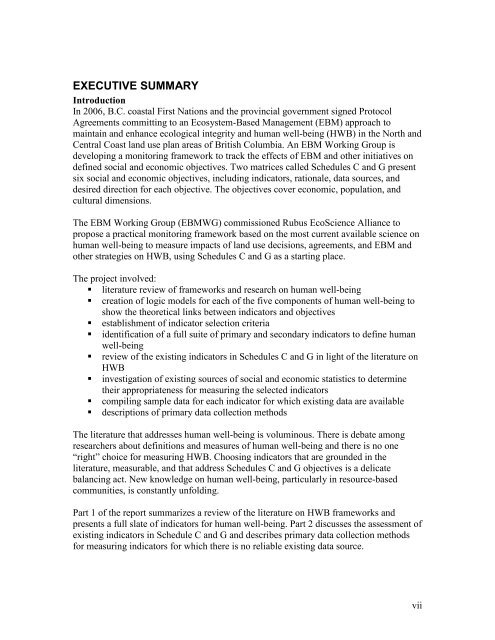Final report - Integrated Land Management Bureau
Final report - Integrated Land Management Bureau
Final report - Integrated Land Management Bureau
Create successful ePaper yourself
Turn your PDF publications into a flip-book with our unique Google optimized e-Paper software.
EXECUTIVE SUMMARY<br />
Introduction<br />
In 2006, B.C. coastal First Nations and the provincial government signed Protocol<br />
Agreements committing to an Ecosystem-Based <strong>Management</strong> (EBM) approach to<br />
maintain and enhance ecological integrity and human well-being (HWB) in the North and<br />
Central Coast land use plan areas of British Columbia. An EBM Working Group is<br />
developing a monitoring framework to track the effects of EBM and other initiatives on<br />
defined social and economic objectives. Two matrices called Schedules C and G present<br />
six social and economic objectives, including indicators, rationale, data sources, and<br />
desired direction for each objective. The objectives cover economic, population, and<br />
cultural dimensions.<br />
The EBM Working Group (EBMWG) commissioned Rubus EcoScience Alliance to<br />
propose a practical monitoring framework based on the most current available science on<br />
human well-being to measure impacts of land use decisions, agreements, and EBM and<br />
other strategies on HWB, using Schedules C and G as a starting place.<br />
The project involved:<br />
literature review of frameworks and research on human well-being<br />
creation of logic models for each of the five components of human well-being to<br />
show the theoretical links between indicators and objectives<br />
establishment of indicator selection criteria<br />
identification of a full suite of primary and secondary indicators to define human<br />
well-being<br />
review of the existing indicators in Schedules C and G in light of the literature on<br />
HWB<br />
investigation of existing sources of social and economic statistics to determine<br />
their appropriateness for measuring the selected indicators<br />
compiling sample data for each indicator for which existing data are available<br />
descriptions of primary data collection methods<br />
The literature that addresses human well-being is voluminous. There is debate among<br />
researchers about definitions and measures of human well-being and there is no one<br />
“right” choice for measuring HWB. Choosing indicators that are grounded in the<br />
literature, measurable, and that address Schedules C and G objectives is a delicate<br />
balancing act. New knowledge on human well-being, particularly in resource-based<br />
communities, is constantly unfolding.<br />
Part 1 of the <strong>report</strong> summarizes a review of the literature on HWB frameworks and<br />
presents a full slate of indicators for human well-being. Part 2 discusses the assessment of<br />
existing indicators in Schedule C and G and describes primary data collection methods<br />
for measuring indicators for which there is no reliable existing data source.<br />
vii
















